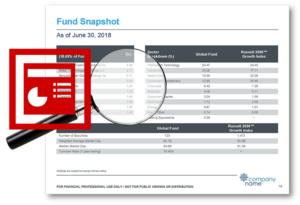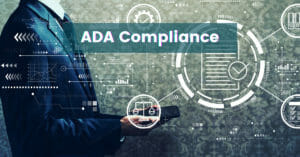A Few Notes From Our Tailored Shareholder Report Webinar
“Marketing has a very large place at the table.”
“There are a whole host of requirements [around ADA compliance] that aren’t going to be fun.”
“Having good discipline… is especially important as fund boards… make inquiries about the due diligence you are performing.”
“I would not want to be the asset manager that misses the deadline”
In our recent webinar, “Are Your Systems Ready? 6 Questions to Answer About the Tailored Shareholder Rule,” we covered a lot of ground across the areas of compliance, operations and technology, and project management.
In a free-flowing one hour discussion that ran from compliance to operations and technology to project management and execution (view the whole thing here) justice , here are a sampling of the things we discussed.
1. How will the new TSR rule broadly change our existing reporting regimens?
“It’s a fund fact sheet on steroids.” Cathy Vasilev, COO Red Oak Compliance
There was a lot going on here. At once the TSR is much closer to an institutional fact sheet than what’s been found in the traditional shareholder reporting communications, yet it’s a fact sheet with 8 SEC-mandated data sets, in addition to whatever else a fund manager wants to include.
What this means is that the document has to be longer than a traditional fact sheet, yet still adhere to the plain language standard, as well as maintain the “concise” mandate from the SEC.
It occurred to us, post webinar, that in a very real way, the Tailored Shareholder Report has to meet a “Goldilocks Standard” for length, tone, and data; balancing the demands of the mandate itself with the intrinsic need for differentiation and a consistent branding that all communications must strike.
2. What are some under the radar compliance issues that need to be accounted for?
Plan for ADA compliance. There’s a whole host of ADA compliance issues that, while not currently mandated, are coming down the pike, so it is important to ensure those issues are included now in the initial planning stages in order to ensure a smooth transition into ADA compliance when the time comes.
ADA compliance requires a truly extensive list of requirements, from image color saturation levels to an accounting for screen contrast levels to multi-factor (for lack of a better term) hyperlink presentation. While none of this is new to those in the banking industry, as they have been subject to ADA requirements for some time, those in the asset management industry will be getting a crash course shortly.
3. How can we tell if our systems are capable?
An underrated, yet important part of this assessment is to answer the question: do we have scalable business processes? As John Toepfer, Synthesis CEO and Founder, said:
“The whole idea is to engineer a program that [does not leverage] an existing piece of technology, or a vendor, unless it is the right [one] for the job, as judged by what the efficiency, scalability, survivability of the process is going to look like over time.”
Are these the right processes? What do we need to add internally? What do we need to look at from the vendor side that can support the internal systems already in place?
An important corollary to this line of thinking goes to a different discussion in the webinar (which we will touch on in a bit): who should be part of the planning and execution process?
We have seen in certain cases that fund Marketing teams have been sidelined in the TSR process, as there seems to be a perception that shareholder reporting is a different animal than marketing collateral publishing.
Whether that’s true from a historical perspective is a question for a different purpose. What’s true now is that, as Cathy alluded to above, the TSR is a fact sheet for fund investors. Fact sheets are data-driven, business- and brand-building documents that now share too many similarities to TSRs to ignore.
So when reviewing internal and external processes and trying to understand where existing vendors can add value and where new one might be appropriate, the Marketing team is an important resource to tap.
4. How can we evaluate potential vendor solutions?
The core of any vendor solution has to include the strength of the automation engine powering the entire system. And an important, yet underrated part of automation in the data-driven publishing world is the ability to incorporate a compliance- and business rules-based backbone to the automation process.
When we look at an existing publishing platform, we need to know:
Do business rules or ad hoc decisions determine what’s included in a document?
If it’s the latter, we can’t really argue that the system is truly rules driven in a meaningful way. Here’s an example:
When a new document or product is added, a scalable and automated solution will enable you to simply input a few new entries into a control table, making sure the data flows and documents simply “appear” – there is no need to search for the proper template or “save as” an old template that you wish rewrite for a new document.
It also ensures that any changes made to a document will ripple through every share class iteration of that fund’s TSR. A truly rules-driven solution will not entail a bunch of people typing & saving documents as fast as they can.
It’s important to keep in mind that every manual interaction with data increases the likelihood of that data becoming corrupted or improperly managed. Business rules must rule.
5. From a project management standpoint, what key planning elements must we consider?
Looking specifically at vendor selection, panelist Gerry Healy mentioned an idea that came up several other times in the webinar: the notion of survivability.
Perhaps a process or tool or vendor fits now, but what about next year? 5 years? 10 years? Certainty become ever-less certain as we move further along the timeline, but there are steps an asset manager can take now to help predict how well decisions made today will age.
Sure, maybe a vendor meets current requirements, but funds should ask to see product roadmaps to ensure that the vendor and the fund are moving in the same direction. Increasing automation? AI? Where is it going? As much as possible, try to understand how well things might fit down the road. Doing so creates a stronger sense of partnership, rather than a vendor-vendee relationship.
And finally, who should be involved in the process?
- Fund Treasury
- Marketing (they have significant experience in quarterly publication of the firm’s fact sheets and their insight here is invaluable)
- Legal & compliance
- Data management and technology (to ensure tech feasibility & can assess if things can be ready to go on Day 1)
- Performance team (there are significant changes to performance reporting for the TSR, so whether it’s an internal team or a vendor, have them involved)
- Distribution & fulfillment (given the new 30e3 requirements, their input is important)
- Any related service providers or external tech vendors whose work might touch the TSR process
- Also, it is a good idea to keep auditors informed on the progress & approach
6. In terms of executing the strategy, what do we need to be thinking about?
The first (and middle and last) step in executing any business strategy, TSRs included, is having an operating model for the project that extends from planning all the way through execution and beyond.
When we say “operating model,” to what are we referring? Gerry defined it as such: a logical arrangement of functions that an organization needs to perform.
When it is set in motion, it’s about ensuring that the right work is performed by the right people at the right time in the right places using the right processes and leveraging the enabling technology to its greatest effect.
A modern, durable, well-controlled operating model within asset management firms tend to be:
- Centralized (for scale & consistency)
- Specialized (via key features and/or quality)
- Automated (to ensure scale, consistency, and quality are achieved), and
- Supported by SLAs and other relevant policies and procedures.
Firms that most quickly can get all of these things lined up are best positioned to meet timely TSR deadlines specifically, and any emerging regulatory frameworks more broadly. Such systems will also help firms to better realize the benefits of scale, efficiency, and cost reduction – the “coin of the realm,” as it were – in asset management middle and back office systems.
In sum…
Check out the whole thing here.







 Compare the Top 3 Finserv Content Automation Vendors [White paper]
Compare the Top 3 Finserv Content Automation Vendors [White paper] Create Pitchbooks the Drive Sales [White paper]
Create Pitchbooks the Drive Sales [White paper] Build vs. Buy: Should Your Financial Services Firm Outsource or Insource Marketing Technology? [White paper]
Build vs. Buy: Should Your Financial Services Firm Outsource or Insource Marketing Technology? [White paper]  10 Tips for Rebranding your Fund Marketing Documents [White paper]
10 Tips for Rebranding your Fund Marketing Documents [White paper]

